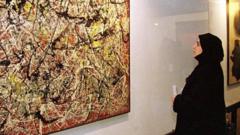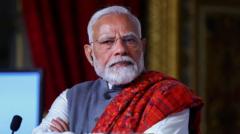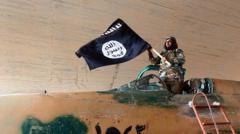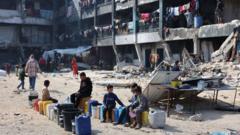The remnants of Iranian military bases in Syria illustrate a chaotic retreat following years of strategic buildup. Amid a shift in power dynamics, the influence of Iran, once pivotal for Bashar al-Assad's regime, appears to be crumbling as new authorities take a stand against Iranian presence.
The Collapse of Iran's Military Ambitions in Syria: A Retreat into Ruins
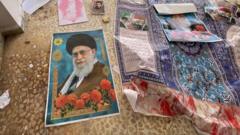
The Collapse of Iran's Military Ambitions in Syria: A Retreat into Ruins
Years of Iranian military development in Syria have been abruptly halted, leaving behind abandoned bases and strategic failures as key turns in the Syrian conflict unfold.
In the aftermath of a decade-long militaristic presence, Iranian bases in Syria lay abandoned, encapsulating a fast-approaching exodus. These sites, once bustling with armed forces and foreign militias, now host discarded uniforms, unfinished meals, and remnants of an unsuccessful campaign. The Iranian regime, a significant ally of Syrian President Bashar al-Assad, had constructed intricate networks of military facilities to fortify its influence under the guise of supporting the regime against so-called jihadi threats.
Located near Khan Shaykhun in Idlib province, one notable site known as the Position of Martyr Zahedi has become a ghostly reminder of Iran's ambitions. The base barely visible from the main road is now occupied by armed Uyghur fighters from Hayaat Tahrir al-Sham (HTS), a change in caretakers that starkly illustrates the shifting control in the region. The hurried departure of Iranian forces led to a hasty evacuation, as evidenced by the discovery of daily supplies and sensitive documents left behind.
The Iranian military operations were primarily justified as defensive stances against Sunni radicalism and a protective measure for Shia holy sites. However, the recent external and internal pressures have culminated in an unexpected downfall. The rapid acceleration of Assad's regime challenges came sharply into focus following Hamas's attack on Israel, leading to intensified strikes against Iranian affiliates in Syria.
Complicity in the situation suggests a crumbling trust between Iranian forces and Assad’s regime, as accusations of betrayal arose in the face of military setbacks. The speed of the Iranian withdrawal likely caught operatives off guard, resulting in a breakdown of strategic positions and a scattering of forces toward Iraq, Lebanon, and Russian installations.
Locals in abandoned Iranian-occupied areas express relief at their abrupt exit but recount the hardships endured under foreign military presence. The emotional response to the lingering effects of Iranian occupation highlights a complex sentiment; while Iran once provided material support, its presence was often viewed more sourly compared to the perceived detachment of Russian forces.
In the wake of these developments, Syria's new leadership has taken stern measures against Iranian nationals while leaving the door open for potential cooperation, raising questions about the future of Iran's role in Syria. Statements from Syrian President Sharaa mark a significant shift, with explicit condemnation of Iran's influence in the nation. Yet, the simultaneous call for a balanced relationship reflects the intricate realities of regional diplomacy.
As the dust settles on the aftermath of Iran's military ambition, what remains are scarred landscapes and a populace poised for a future without the shadow of Iranian expansion looming overhead. The last remnants of Iran's military presence symbolize the intricate changes poised to reshape Syria's geopolitical landscape, leaving observers astutely aware of the realities that lie ahead.
Located near Khan Shaykhun in Idlib province, one notable site known as the Position of Martyr Zahedi has become a ghostly reminder of Iran's ambitions. The base barely visible from the main road is now occupied by armed Uyghur fighters from Hayaat Tahrir al-Sham (HTS), a change in caretakers that starkly illustrates the shifting control in the region. The hurried departure of Iranian forces led to a hasty evacuation, as evidenced by the discovery of daily supplies and sensitive documents left behind.
The Iranian military operations were primarily justified as defensive stances against Sunni radicalism and a protective measure for Shia holy sites. However, the recent external and internal pressures have culminated in an unexpected downfall. The rapid acceleration of Assad's regime challenges came sharply into focus following Hamas's attack on Israel, leading to intensified strikes against Iranian affiliates in Syria.
Complicity in the situation suggests a crumbling trust between Iranian forces and Assad’s regime, as accusations of betrayal arose in the face of military setbacks. The speed of the Iranian withdrawal likely caught operatives off guard, resulting in a breakdown of strategic positions and a scattering of forces toward Iraq, Lebanon, and Russian installations.
Locals in abandoned Iranian-occupied areas express relief at their abrupt exit but recount the hardships endured under foreign military presence. The emotional response to the lingering effects of Iranian occupation highlights a complex sentiment; while Iran once provided material support, its presence was often viewed more sourly compared to the perceived detachment of Russian forces.
In the wake of these developments, Syria's new leadership has taken stern measures against Iranian nationals while leaving the door open for potential cooperation, raising questions about the future of Iran's role in Syria. Statements from Syrian President Sharaa mark a significant shift, with explicit condemnation of Iran's influence in the nation. Yet, the simultaneous call for a balanced relationship reflects the intricate realities of regional diplomacy.
As the dust settles on the aftermath of Iran's military ambition, what remains are scarred landscapes and a populace poised for a future without the shadow of Iranian expansion looming overhead. The last remnants of Iran's military presence symbolize the intricate changes poised to reshape Syria's geopolitical landscape, leaving observers astutely aware of the realities that lie ahead.


